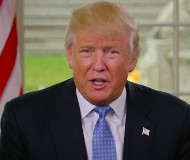11/29/2016
OPINION: Draining the transportation swampA recommendation to the incoming administration on improving infrastructure by preserving the interstate highway system.

President-elect Donald J. Trump says boosting America's infrastructure will be among his top priorities when he moves into the Oval Office on January 20. His campaign promise to fix bridges and build new roads by leveraging new revenue sources such as "public-private partnerships, and other prudent funding opportunities" has raised concern. "Public-private partnership" is a euphemism for the unpopular idea of a toll road.
At the same time, the majority of tolling projects involve turning over America's roads to foreign-owned companies, which would be hard to square with another campaign promise to "Refocus government spending on American infrastructure and away from the Obama-Clinton globalization agenda."
The incoming administration can thread the needle of its promises and achieve its overall goal by putting an end to the federal government's infatuation with toll roads.
First, there's nothing prudent about choosing a project funding mechanism that will likely go bankrupt. The first high occupancy toll project, 91 Express Lanes in Orange County, California, was also the first to go bust. It has recently been followed by the nearby South Bay Expressway in San Diego, and despite over a billion in taxpayer subsidies the 241, 261 and 133 toll roads carry an unsustainable debt load. The Greenville Southern Connector in South Carolina went under in 2010, the Pocahontas Parkway in Richmond, Virginia was written off in 2012, and the Indiana Toll Road went belly up in 2014. State Highway 130 in Texas went bust earlier this year.
Foreign-owned finance companies get rich quick by investing very little of their own capital before flipping these asset schemes, leaving creditors and motorists stuck with the bill. It is clear that the federal transportation bureaucracy has lost sight of what made our infrastructure great in the first place -- the focus on building freeways for everyone's use.
Federal involvement was critical to the effort of building a world-class interstate road network that began in 1956. At today's prices, one mile of highway costs between $7 and $11 million to build, and large rural states simply do not have the budget to support roads stretching for hundreds of miles now any more than they had decades ago. So funds paid at the pump in populous states subsidized construction in less populated areas, so that freight trucks could move unimpeded from one end of the country to the other without having to stop at a toll booth. The free movement of goods benefits everyone.
The excise tax on gasoline proved to be the perfect pay-as-you-go tax. It was first put in place in the 1930s as a way to "temporarily" raise federal funds. It grew into a war-funding measure in the 1940s. By the time the '50s rolled in, it became the natural mechanism to pay for interstate highway construction. Only people who use roads pay the gas tax. If they use more road, they pay more. Those choosing efficient vehicles pay less. It couldn't be simpler.
The gas tax is not actually collected at the gas pump. Rather, it is paid by a handful of distributors which makes collections simple and easy.
Toll roads, by contrast, are remarkably inefficient. Even today's most high-tech toll collection systems require a phenomenal amount of overhead to run, as the sophisticated electronic systems need constant monitoring and maintenance. Any time credit cards are involved, you need a legal department, customer service and billing. Enforcement requires the use of cameras and transponders that track every trip made on the road, undermining privacy.
Even the best-run toll roads in the country waste about 22 cents out of every $1 toll they collect. This does not compare favorably with Federal Highway Administration figures that show the overhead involved in running the gas tax is less than one percent.
So toll roads are inefficient. They are also unpopular, sparking a grassroots revolt in Florida, Georgia, North Carolina and Texas. Why are they still being pushed in Washington?
The companies that pocket the overhead and profit from tolling have invested a great deal of money in the think tanks, politicians and lobbyists that promote their interests. One of the little noted charges in former Illinois Governor Rod Blagojevich's bribery trial was his scheme to create tolled "Green Lanes" in return for a $500,000 campaign contribution from a construction firm.
Of course, that's just the most extreme example of outright pay-to-play. The much more ordinary version of this is the revolving door between the transportation bureaucracy and the tolling industry.
President Obama's first Transportation chief, Ray LaHood, is lobbying on matters surrounding the Dulles Toll Road in Virginia. George W. Bush's choice, Mary Peters, is a "senior advisor" to Zachary American Infrastructure, a tolling company. Many other lower level officials have made a similar journey that sends the message that those who promote tolls as government officials will be rewarded.
Trump's proposal to impose a five-year lobbying moratorium on administration officials who leave office is a great first step at reform. Yet the only way to fully drain the transportation swamp is to close the revolving door for good. That means repealing the federal authorities that allow existing freeways to be converted into toll roads. It means ending all federal promotion of tolling. It means restoring the interstate highway system to its original vision of roads open to all.


